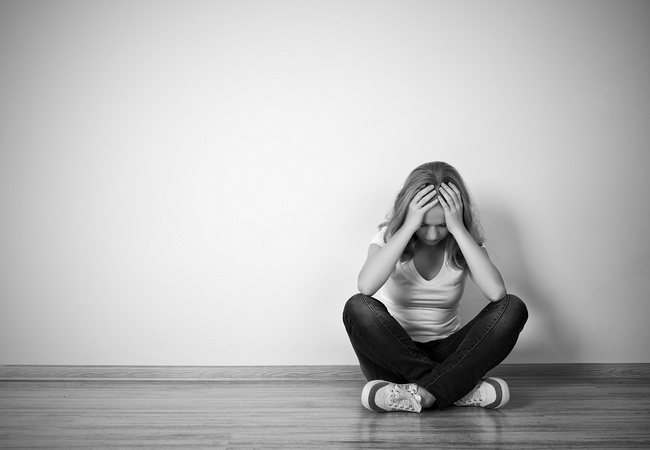- Make It Yourself Lavender Heart-Shaped Bath Bombs!
- 20 Things You Never Knew About “Down There”
- 12 Best Foods For Those Suffering From Arthritis Pain
- 12 Personal Hygiene Mistakes Almost Everyone Makes (Mom Never Told You About #4!)
- 15 Medicinal Plants And Herbs From The Cherokee People
- 12 Mind-Blowing Benefits Of Drinking Coconut Water During Pregnancy
- 12 Outstanding Winter Foods That Won’t Fatten You Up Like A Christmas Turkey
10 Super Ways to Deal with SAD (Seasonal Depression)

Photo credit: bigstock.com
Everyone has heard of the dog days of summer: those endlessly, unbearably hot days that seem like they will never end. Well, think of January and February as the penguin days of winter. These are the dark, freezing cold days that seem like they will never end. Do you find that you become unbearably depressed during these winter months? Not just a longing for summer, but a true depression that makes it almost impossible to even get out of bed in the morning.
It’s estimated that at least 2 percent of the American population suffers from seasonal affectiveness disorder, or SAD. Scientists believe that number is probably higher, as many people simply learn ways to deal with their depression or move to sunnier climates. Of course, in areas where sunlight is at a premium, like Alaska, it’s estimated that about 10 percent of the population experience the symptoms of SAD including a loss of interest in activities, difficult with concentration, overeating, excessive alcohol consumption, and fatigue.
Unfortunately, just like clinical depression, your chances of having SAD increases if your family has a history of depression or other types of mood disorders, Gender can also play a role as studies show that women are four times more likely to experience SAD than men.
What actually causes SAD? The European College of Neuropsychopharmacology published a study in October of 2014 that says it’s most likely a biochemical imbalance that causes this problem. When there is little or no sunlight, persons with SAD have a severe lack in the production of serotonin, the neurotransmitter that affects our appetite, sleep, mood, memory, and libido.
Even those who don’t suffer from a full blown case of SAD can still feel down in the dumps during the winter months. If you know that you have SAD or if you tend to get depressed during the winter months, you can start a preventative approach to minimize the winter time blues. We winterize our homes, our cars, and our patio furniture, so what’s so strange about preparing our bodies and minds for winter?
OK, so no one is suggesting hibernation as a solution, but there are plenty of things you can do to improve your mood and make the winter months easier to bear.
1. Keep Your Routine
Try to keep your regular schedule no matter the time or season. Many people discontinue enjoyable hobbies once daylight savings time kicks in and hide in their bedrooms with their DVD player. Even if it’s difficult to get motivated at first, you will find that you feel better if you make it to your regular brunch with friends, basketball games with the guys, or those weekly church meetings.
2. Dump the Sugar Habit
OK, so you already know that too much sugar adds to our waistline and puts us at risk for developing all kinds of diseases such as diabetes and cancer. Sugar also has a depressive effect on our mental health as well, according to research that shows that countries that consume the most sugar also have the highest rates of depression. Scientists believe that sugar limits the body’s ability to cope with stress and can make anxiety levels even worse.
Many people find that they crave sugar and starchy foods in cold weather because it gives you a temporary energy boost, but this is short lived and eventually it leaves you just as tired as you were before. Limit sugar and eat more protein, fresh vegetables, and fiber.
Continue to Page 2

Photo credit: bigstock.com
3. Try to Relax
You might think that hibernating under the blankets on the sofa IS relaxing, but it’s really not. Try practicing some yoga, meditation, or deep breathing exercises. Studies show that these types of relaxation techniques can change neural networks in the brain and decrease stress, depression, and anxiety. Depending on the weather, try to get outside for a nature walk.
4. Soak Up the Sun
Getting as much sunlight as you possibly can will help, especially in the mornings. Studies show that winter depression is highest when you wake up. Resist the urge to go back to bed. Get up, open the curtains, and if there is any sun at all outside, try to get some of it. The more natural sunshine you can get on your skin, the better you will feel. Read more about surprising things the sun could do for you.
5. Use a Light Box
If you live in an especially dark locale, light boxes help as much as 50 percent of those affected with SAD. The light that comes from these specially made boxes helps the body wake up in the mornings and resets the body’s internal clock so you can sleep better at night. In fact, light boxes work so well that most people say they feel a dramatic improvement in a matter of days. Talk to your doctor about what kind of light box might work best for you.
6. Work it Out
When you are working out hard, your brain tries to override those uncomfortable feelings by telling the body to keep on keeping on. It will release hormones called endorphins, which naturally make you feel happy, even euphoric. The American College of Sports Medicine Journal did a meta-review in 2013 that seemed to suggest that exercise might be comparable to anti-depressant drugs as an effective treatment for depression. It might be hard to get started, but try to do two or three really sweaty workouts each week.
Continue to Page 3

Photo credit: bigstock.com
7. Develop Wintertime Interests
If you love playing volleyball or taking long walks on the beach in the summers, it can be really depressing when you can’t do your favorite activities for the remainder of the year. The key is to find something you really love to do during the winter months so that not only do you enjoy winter, you might even find yourself looking forward to it. Having fun is vital to being in a good mood. It might take you a little while to find the perfect activity that is fun for you, but if you keep trying, almost everyone can find something enjoyable. Try cross country skiing, downhill skiing, snowboarding, or ice skating. If you find that you really hate everything about snow, look for something else such as swimming in an indoor heated pool or taking some cooking classes.
8. Get Outside
Studies show that getting some fresh air can relieve stress. So unless there is a raging blizzard outside, bundle up and take a few deep breaths, even if it’s just for 5 minutes. If you can take a quick walk outside in the morning sun, even better! Get some sunlight in your eyes (not directly, of course) and wake up your body with a little physical activity, it’s the two birds with one stone scenario.
SEE ALSO: Top 15 Natural Ways to Deal with Depression
9. Switch Summer Vacation for Winter Vacation
If you are one of those who suffer from a serious case of SAD, you might find that taking your vacation during the cold winter months, perhaps in late January or early February, might do a lot more for your mental health than a summer vacation. Taking a vacation to a sunny location during the dark days of winter will really make a difference. Even a quick weekend trip someplace where there is more sunlight will help.
10. Fake the Dawn
There are alarm clocks that simulate the rising sun, rather than play music or have a beeping tone. Some people with SAD find that these are really helpful. There are many different models of dawn stimulators, but the best ones for those with SAD use full-spectrum light, which is the closest thing there is to natural sunlight.
If you live with SAD, you might want to try equipping your home and office with lots and lots of bright lights. Some people find that just adding plenty of light, even if it’s artificial light, can help tremendously.
































